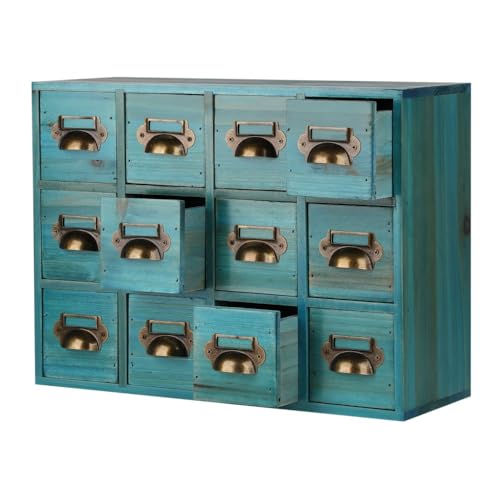
Brief:
BT70 Upscale of Centuri Vulcan with 7x18mm Motor Mount
Construction:
 Construction began with the building of the 7x18mm motor mount from Fliskits meant for the BT70 tube. This was interesting in that normally, 7x18mm mounts will not fit in this tube without some deformation. Fliskits came up with an ingenious solution. At the end of each of the BT20 motor tubes, a coupler tube is inserted. These couplers will fit into a BT70. A series of lunettes around the periphery makes the seal complete.
Construction began with the building of the 7x18mm motor mount from Fliskits meant for the BT70 tube. This was interesting in that normally, 7x18mm mounts will not fit in this tube without some deformation. Fliskits came up with an ingenious solution. At the end of each of the BT20 motor tubes, a coupler tube is inserted. These couplers will fit into a BT70. A series of lunettes around the periphery makes the seal complete.
When the motor mount was done, it sat and waited for a while until I came up with some BT70 tubing. When I got it, I was apprehensive about the fit. The idea from Fliskits seemed good, almost too good to be true. It was true. The mount slipped in easily and was glued in place with yellow glue.
I started to print out the shrouds for the BT70 Vulcan on a big HP plotter on heavy cardstock back in February. My plotter has always been grouchy about thick media and this time I pushed it too far, damaging 2 of the print heads. The cyan and yellow would only work intermittently and I could not get shrouds I was happy with.

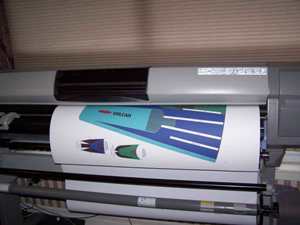
I could not justify the cost of replacing the printheads until a project came along for the church and I got it done. I also decided to print on band paper and laminate that to the heavy stock. The colors came out vibrant and great.
With shrouds that satisfied me in hand, I began to cut them out. I then put a small amount of white glue on the back of then, screeded it across the whole surface and mounted it to the heavy stock, smoothing it out as I went.

The laminated shrouds had a day to dry and I was disappointed to see that some significant wrinkles crept in despite the care I had tried to take earlier. I figured they were wrinkles I could live with and began to cut the individual pieces out.
The laminated shrouds were quite a bit stiffer than the plain cardstock. This should help to strengthen things a bit but it makes rolling the main shroud more difficult. I decided to roll it as tightly as I could and let it sit that way for a week while I was to be out of town. I am glad to have finally found a use for some of those rubber band type shock cords that come with some kits!
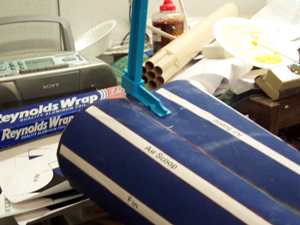 Leaving the body shroud rolled up for most of a week did help. When I got back home, it wanted to stay curled up. I gingerly test fitted it along the tab and then applied some white glue at the aft end and pressed the sides together. I then took a small plastic clamp to hold it more or less in place while I messed with the forward end. I put some white glue on that and clamped it as well and turned to making fine adjustments in alignment. I did not glue the middle part of the shroud at this point.
Leaving the body shroud rolled up for most of a week did help. When I got back home, it wanted to stay curled up. I gingerly test fitted it along the tab and then applied some white glue at the aft end and pressed the sides together. I then took a small plastic clamp to hold it more or less in place while I messed with the forward end. I put some white glue on that and clamped it as well and turned to making fine adjustments in alignment. I did not glue the middle part of the shroud at this point.
The next day, I tackled gluing down the middle portion of the shroud. I needed something besides me to hold it shut while the glue set. I decided to place the glue and press the sides together. I then let them "expand away from each other for a few moments while I got set up for my next step. I had a long wooden dowel, bigger than a BT60 but smaller than a BT70 and pushed that through the inside of the shroud from one end to the other. I then laid a piece of 1x4 along the seam on the outside. Clamps were used to hold the 1x4 to the dowel and keep the middle pressed down.
As the seam on the shroud began to set up, I began considering the fins again. Since the colored paper had been laminated onto the heavy stock with white glue, they were quite stiff; much more so than regular card stock. I began to form the first fin by trimming away all the material up to the folding tab on either side. I did leave the extension lines marking the fold location in place at this time, though. A long steel ruler was then taped into place on the back side of the fin with one edge aligned with the fold line. When I was sure that the ruler would not move, I used it as a stiff edge against which to fold the tab. The procedure was then repeated on the other side. The central fold was accomplished similarly and then the excess material was trimmed from either end.

For the after bulkhead, I used a piece of 1/4" balsa. I cut the cardstock bulkhead out and smeared some white glue along the back. I then placed it on the balsa and applied some clamps to keep it from curling. When the glue was dry and the clamps removed, I still had quite a bit of material to remove. When I built my BT60 clone of the Vulcan, I removed most of that with an X-acto and then finally remembered the belt sander when there was not too much left to do. This time, I went straight to the sander and, for some reason, noticed the disk and decided to give that a try. It was the right choice. I could set the piece on the little shelf and gently feed it into the disk sander, stopping when I got to a line. It was the best one of these things, and the easiest, I had produced to date.

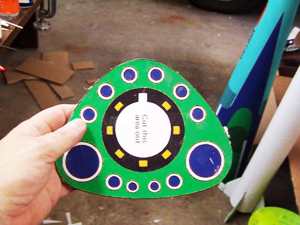
Cutting out the central circle was not so simple. I used the brute force approach with an X-acto knife and the results were fairly rough. I cleaned up the rough edges with sandpaper and then test fitted the BT70 body tube. The bulkhead was then test fitted in the body shroud but not glued at this point.


In previous Vulcans, the motor mount had not extended much aft of the bulkhead. In this one, however, I was going to let the full length of the mount protrude. With that in mind, I decided to go ahead and paint the aft portion of the body tube/motor mount. I set it up in the booth and primed it with 2 coats of white. When that was dry, the rear end got 2 coats of hammered silver.


I knew I was going to need 2 lengths of BT70 for the length of the shroud. When I test fitted the tube with the motor mount and noted the location of the coupler/baffle, I realized that packing a chute would be a tight matter in the space left to me for the upper tube. For that reason, I inserted a mandrel and trimmed off about 5" of the tube with the motor mount.

A ring of yellow glue was then swabbed around the cut end of the body tube and the baffle was inserted. When the glue had dried sufficiently, another ring of glue was applied in the end of another BT70 tube and the 2 tubes were joined together.

 The extended body tube was fit into the aft bulkhead so that the cluster mount protruded from the rear end. The tube and bulkhead were then fitted into the shroud and the forward end was marked where it poked through. The tube was then removed and cut down to length.
The extended body tube was fit into the aft bulkhead so that the cluster mount protruded from the rear end. The tube and bulkhead were then fitted into the shroud and the forward end was marked where it poked through. The tube was then removed and cut down to length.
I wanted to use an internal launch lug on this rocket since doing so had served me well on my original Vulcan Clone and on my BT60 upscale. Looking around my shop, though, I had only 2 6" pieces of 1/4" lug. I tried using some MMX tubing but the BT2 would not fit, the BT2.5 was very tight and the BT3 had a lot of slop in it from being too loose. I was trying to remember from where I had obtained my previous 6" lengths with the plan of splicing sufficient lengths together to run the length of the tube when I realized that the loose fit of the BT3 over a long distance would not be a problem. With that in mind, I joined 2 pieces with masking tape.
The super lug was trimmed to the length of the body tube and then a line was run the length of the tube. Yellow glue was applied along the line and the lug was pressed into place and held there to dry with the application of some tape.
The central tube, bulkhead an lug were all test fitted to make sure that everything would line up as intended. A batch of 15 minute epoxy was then mixed to put it all together. I used a brush to paint a ring around the forward end where the BT would emerge and also painted some around the junction with the motor mount. Things were then slid back together and eased into place. I was going to use the remaining epoxy to "paint" the aft bulkhead into the shroud and firmly fix the motor mount but it decided to suddenly set up on me as I was about to make the first brush stroke. It was ugly.
I quickly threw the post away and opened my big can of ethanol to try and clean up some of the mess while it was still semi-soft. That being done, I mixed another batch and quickly pained things into place.
I took the occasion of letting the epoxy set up as an opportunity to tie a long piece of sewing elastic to the Kevlar®. The knot was fixed with some white glue.
The closure of the shroud around the body tube at the front end was not perfect. To rectify matters, I smeared some white glue into the gaps and pressed the shroud down. Holding it down got old quickly so I held it in place to dry with some masking tape.
I started the process of mount the first fin by taking down one edge with white glue. It was not my intention to rely of the white glue except as a temporary expedient.




Letting the tacking of the first edge of the first fin dry gave me the opportunity to consider the cockpit canopy. I decided to go with the easier version, cut it out, folded it and glued it into shape, again using white glue.
When the glue sealing the shroud to the forward end of the BT had a day or so to dry, the tape was removed and the shroud was indeed better adhered to the tube. A little trimming still needed to be done to make things look better and neater but the main goal had been achieved.
Whereas in my previous BT60 upscale of the Vulcan, I had just used a plastic Estes nose cone that was "close enough", this time I wanted to do it right. I contacted Gordon Agnello of Roachworks and he turned a custom balsa cone for me. It was beautifully done and, being justifiably proud of his work, it had his signature on the tail end. I hardened and sealed the NC by drizzling on a coating of thin CA and letting it harden. When hard, I gently sanded it with some #400 sandpaper.

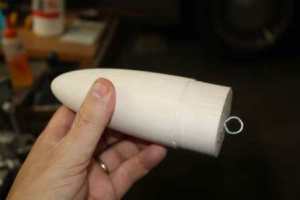
Allowing the CA to fully cure on the nose cone let me turn my attention back to the installation of the fins. The first had already been tacked on and now it was time to do the same with the second one. Again, white glue was used at this stage just to get the fin into place.
Wrestling with the fins gave plenty of time for the CA to dry on the NC. The NC was then sanded with #400, taken to the booth and primed with 2 coats of Kilz. After a day to dry, the primed NC was sanded again with #400.
The vertical tail fin was applied in the same manner as the two wing fins. It was tacked into place with white glue.


The NC having had a day to dry and been sanded was taken to the booth and given 2 coats of blue. When dry, the painted cone was tied into the elastic of the shock cord and fitted for the first time into the body.
The air scoop on the ventral surface of the rocket was applied with white glue in the manner of the tail and wings.
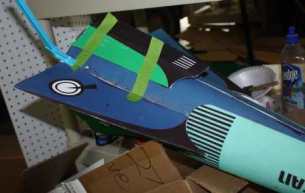

When all of the paper fins, tails, scoops and cockpits were in place with white glue, I wanted to make sure they stayed in place. It was never my intention to rely just on the glue. With that in mind, I mixed some 15 minute epoxy and used a brush to reinforce all of the seams. I did this twice, building up a pseudo-fillet in each case. I was also kind of messy and drizzled epoxy where I did not want it.
After fuming for a while, I thought I could make the blunder work to my advantage. I was using the same stock for the shrouds that I had used for my BT60 upscale but the distance between support is greater in this one. Its different enough that I worried about the integrity of the shroud. Not having very much epoxy experience, I decided to paint the entire shell in the hopes that would stiffen it up and protect the dye from the transfers.

Doing that was a long process. Even the 30 minute epoxy seemed to be curing in only about 8 minutes so I wasted a lot in the early stages. I also didn't control blobs as well as I would have wished. From a distance, though, it does have a glossy appearance and doesn't look too bad.
As this project finally began to wind down, I realized that the issue of nose weight was one that was going to come back and bite me. Since I don't do RocSim, I took a qualitative as opposed to quantitative approach. I knew what worked in my BT60 upscale and have the sense that it was a bit more than needed. With that in mind, I decided to try going with about the same amount in this version.
Since this one has a balsa nosecone instead of a hollow plastic one, the epoxy embedded BBs were not going to do it. I went to a hardware store and bought 2 large diameter washers that massed about the same as the BBs. The eye screw was removed and a bed of epoxy was smeared on the base of the cone, making sure that it went into the screw hole. A washer was then set in place on the epoxy and the screw inserted again. A bit more epoxy was mixed and slathered on the top of the first washer. The second was then set in place on top of it. The epoxy had not fully cured and a few drops more were mixed and used to fill the central cavity of the washers and lock the screw into place.
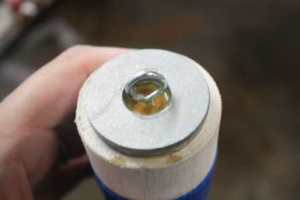

The epoxy on the weights got a day to dry and then the cone was tied into the elastic. That means that the Big Blue Vulcan is ready to take to the air!


Flight:
The Big Blue Vulc sat around from August to January after being finished without ever getting to fly. I wanted to make sure that all the motors of the cluster lit off so I wanted to use the new Quest igniters. I just kept putting off the ordering of them. I finally ordered some just before Christmas and received them just in time for my Club's January launch.
I installed a Nomex protector and a 24" nylon chute and then began to prep the motors. I decided to use the new Quest long burning C6-3s. They seemed to be a little fatter than the older European Quest motors and they fit snugly into the mount. They were tight enough that I was not worried about friction fitting. The Quest igniters were nice also and their design made twisting the leads together nice. The plastic straws that protect the pyrogen were supposed to be used as plugs. I found that they did not fit the nozzles too well until I took an X-acto and sharpened the ends a bit. Then they worked fine.
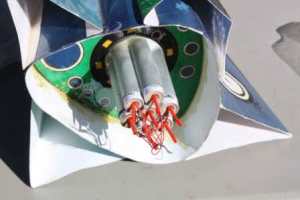

When I got things set up at the pad, I warned everyone that this was a heads up flight. It looked good sitting there and I was eager to press the button. At ignition, it was looking good. All 7 motors seemed to have lighted off and the Big Blue Vulcan rose off the rod. The flight looked good early on. Their was no wobble as is common with my original Vulcan or my BT60 upscale. It did, however, begin to tip over. This occurred during the powered phase of flight. I got a sick feeling when I decided that it was definitely pointing downward and I could still see flames coming out of the motors. When the motors did burn out, I waited anxiously for the ejection charge to save my months of work. I wondered if maybe some C6-45s had been labelled as C5-3s and it kept plummeting downward. It then disappeared behind the GSE truck and I was delighted to hear Todd exclaim that he had seen a good ejection. He neglected to mention immediately that the ejection took place AFTER impact with the ground.





Summary:
An examination of the carcass was instructive. All 7 motors did ignite and it took off well enough. It just could not stay oriented vertically. There was not enough thrust. Later in the day I had a similar experience with another rocket flying on a Quest C6. It too seemed underpowered. Immediately afterward, that same rocket behaved wonderfully on an Estes C6. Having a bigger spike might have saved the Vulcan. A better option though would have been to use a larger motor mount.


The motor mount was the only part of the rocket to survive unscathed. The nose cone was dinged up pretty well and the body tube was crumpled at the forward end. It was not worth repairing and I gave it to an excited boy from my club to fool around with.
#Related Reviews
- Centuri Vulcan By Bill Eichelberger
As a part of the Centuri "paper brigade" that included the Point and the X-24 Bug, the Vulcan always looked like an intriguing rocket to clone. Despite having printed out the patterns I couldn't bring myself to start the project. Something about the idea of constructing a rocket out of pre-printed ...
- Scratch Vulcan 60 By John Lee
Brief: Since I was a kid, I have always been captivated by the paper shrouded rockets like "The Point". My biggest nemesis, however, was always the Centuri Vulcan. I built lots of them but never got one to behave or even look very good...until I became a BAR and cloned one. It's not the best flier ...
Related Products
Sponsored Ads
 |
 |




